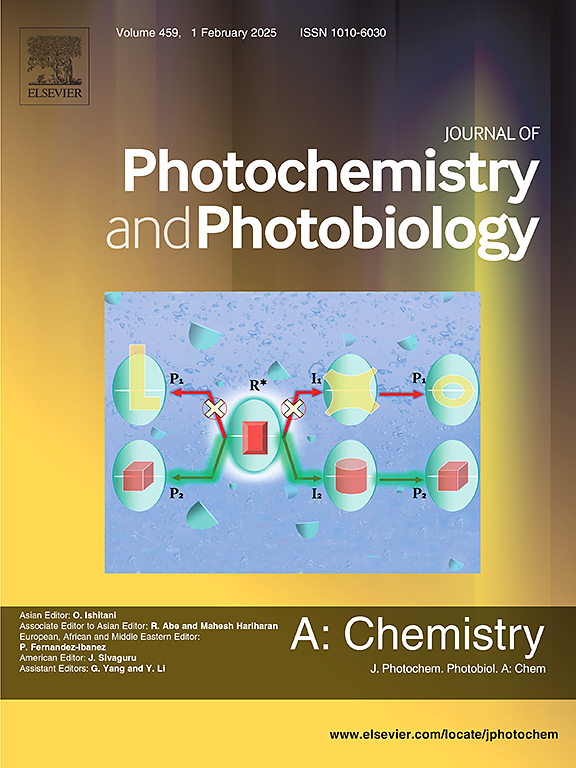First fluorometric sensor for dronedarone detection based on aggregation-induced quenching of red-emissive carbon dots: Application to pharmacokinetics
IF 4.7
3区 化学
Q2 CHEMISTRY, PHYSICAL
Journal of Photochemistry and Photobiology A-chemistry
Pub Date : 2025-06-02
DOI:10.1016/j.jphotochem.2025.116535
引用次数: 0
Abstract
Dronedarone (DND) is a widely used antiarrhythmic drug, and accurate determination of its concentration is crucial for therapeutic monitoring and pharmacokinetic studies. In this work, we report the first fluorometric method for the detection of dronedarone, based on the quenching effect of DND on the red emission of carbon dots (RCDs). The detection mechanism relies on electrostatic interactions between the positively charged DND molecules and negatively charged RCDs in an acidic medium, which induces aggregation of the RCDs and results in significant fluorescence quenching. This quenching enables highly sensitive quantification of DND, achieving a detection limit of 2.31 ng/mL and a wide linear range of 5–200 ng/mL with excellent linearity (R2 = 0.9985). The mechanism of detection and thorough characterization of the RCDs were comprehensively investigated. The proposed method also demonstrated outstanding selectivity when applied to both spiked and real rat plasma samples, supporting its potential use in pharmacokinetic evaluations of dronedarone.

基于红碳点聚集诱导猝灭的首个无人机酮检测荧光传感器:在药代动力学中的应用
Dronedarone (DND)是一种广泛应用的抗心律失常药物,其浓度的准确测定对治疗监测和药代动力学研究至关重要。在这项工作中,我们报告了基于DND对碳点(rcd)红色发射的猝灭效应的第一个检测drone - edarone的荧光法。检测机制依赖于带正电的DND分子和带负电的RCDs在酸性介质中的静电相互作用,这种静电相互作用诱导RCDs聚集并导致显著的荧光猝灭。这种猝灭可以实现DND的高灵敏度定量,检测限为2.31 ng/mL,线性范围为5-200 ng/mL,线性度良好(R2 = 0.9985)。对rcd的检测机理和表征进行了全面的研究。当应用于加标和真实大鼠血浆样品时,所提出的方法也显示出出色的选择性,支持其在drone - edarone药代动力学评估中的潜在应用。
本文章由计算机程序翻译,如有差异,请以英文原文为准。
求助全文
约1分钟内获得全文
求助全文
来源期刊
CiteScore
7.90
自引率
7.00%
发文量
580
审稿时长
48 days
期刊介绍:
JPPA publishes the results of fundamental studies on all aspects of chemical phenomena induced by interactions between light and molecules/matter of all kinds.
All systems capable of being described at the molecular or integrated multimolecular level are appropriate for the journal. This includes all molecular chemical species as well as biomolecular, supramolecular, polymer and other macromolecular systems, as well as solid state photochemistry. In addition, the journal publishes studies of semiconductor and other photoactive organic and inorganic materials, photocatalysis (organic, inorganic, supramolecular and superconductor).
The scope includes condensed and gas phase photochemistry, as well as synchrotron radiation chemistry. A broad range of processes and techniques in photochemistry are covered such as light induced energy, electron and proton transfer; nonlinear photochemical behavior; mechanistic investigation of photochemical reactions and identification of the products of photochemical reactions; quantum yield determinations and measurements of rate constants for primary and secondary photochemical processes; steady-state and time-resolved emission, ultrafast spectroscopic methods, single molecule spectroscopy, time resolved X-ray diffraction, luminescence microscopy, and scattering spectroscopy applied to photochemistry. Papers in emerging and applied areas such as luminescent sensors, electroluminescence, solar energy conversion, atmospheric photochemistry, environmental remediation, and related photocatalytic chemistry are also welcome.

 求助内容:
求助内容: 应助结果提醒方式:
应助结果提醒方式:


